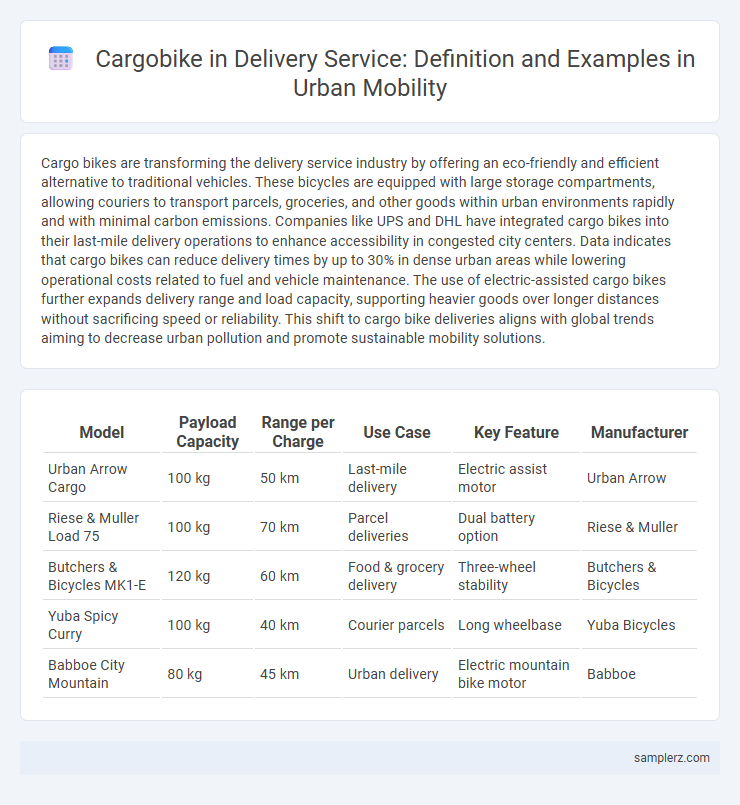Cargo bikes are transforming the delivery service industry by offering an eco-friendly and efficient alternative to traditional vehicles. These bicycles are equipped with large storage compartments, allowing couriers to transport parcels, groceries, and other goods within urban environments rapidly and with minimal carbon emissions. Companies like UPS and DHL have integrated cargo bikes into their last-mile delivery operations to enhance accessibility in congested city centers. Data indicates that cargo bikes can reduce delivery times by up to 30% in dense urban areas while lowering operational costs related to fuel and vehicle maintenance. The use of electric-assisted cargo bikes further expands delivery range and load capacity, supporting heavier goods over longer distances without sacrificing speed or reliability. This shift to cargo bike deliveries aligns with global trends aiming to decrease urban pollution and promote sustainable mobility solutions.
Table of Comparison
| Model | Payload Capacity | Range per Charge | Use Case | Key Feature | Manufacturer |
|---|---|---|---|---|---|
| Urban Arrow Cargo | 100 kg | 50 km | Last-mile delivery | Electric assist motor | Urban Arrow |
| Riese & Muller Load 75 | 100 kg | 70 km | Parcel deliveries | Dual battery option | Riese & Muller |
| Butchers & Bicycles MK1-E | 120 kg | 60 km | Food & grocery delivery | Three-wheel stability | Butchers & Bicycles |
| Yuba Spicy Curry | 100 kg | 40 km | Courier parcels | Long wheelbase | Yuba Bicycles |
| Babboe City Mountain | 80 kg | 45 km | Urban delivery | Electric mountain bike motor | Babboe |
Leading Cargobike Models Revolutionizing Urban Deliveries
Leading cargobike models such as the Urban Arrow Family and Riese & Muller Load are revolutionizing urban deliveries with enhanced cargo capacity and electric-assist features. These models optimize last-mile logistics by providing eco-friendly, efficient, and nimble transportation solutions in congested city environments. Their innovative design supports heavy loads while reducing delivery time and carbon emissions for sustainable urban mobility.
Case Studies: Cargobike Adoption in Major Cities
Cargobike adoption in major cities such as Amsterdam, Copenhagen, and Berlin demonstrates significant improvements in delivery efficiency and urban sustainability. Case studies reveal that companies utilizing cargobikes reduce traffic congestion and carbon emissions while enhancing last-mile delivery speed in dense urban environments. Data from these cities show a 30-40% decrease in delivery times and a substantial drop in air pollution levels linked to traditional delivery vehicles.
Comparing Electric vs. Manual Cargobikes for Last-Mile Logistics
Electric cargobikes enable faster delivery times and increased payload capacity, making them ideal for urban last-mile logistics where efficiency and speed are crucial. Manual cargobikes offer lower operational costs and environmental benefits by eliminating battery use but may face limitations in distance and load capacity. Choosing between electric and manual cargobikes depends on factors such as delivery volume, route terrain, and sustainability goals for the logistics service.
Successful Retailers Using Cargobikes for Delivery
Successful retailers like IKEA and DHL integrate cargobikes into their delivery services, reducing urban congestion and carbon emissions while ensuring efficient last-mile logistics. These businesses leverage electric cargobikes to navigate narrow city streets and pedestrian zones, enabling faster delivery times and improved customer satisfaction. Data shows that retailers using cargobikes have cut delivery costs by up to 30% and significantly contribute to sustainable urban mobility.
Environmental Impact: Cargobikes vs. Traditional Vans
Cargobikes significantly reduce carbon emissions compared to traditional delivery vans, emitting zero tailpipe pollutants and decreasing urban air pollution. Their electric or human-powered operation consumes far less energy, lowering the overall environmental footprint of last-mile deliveries. This shift supports sustainable urban mobility by reducing noise pollution and traffic congestion in densely populated areas.
Innovative Cargobike Technologies Enhancing Delivery Service
Innovative cargobike technologies, such as electric-assist motors and modular cargo compartments, significantly enhance delivery service efficiency by reducing delivery times and expanding carrying capacity. Advanced GPS tracking and smart routing systems integrated into these cargobikes optimize navigation in urban environments, lowering fuel consumption and emissions. These developments enable last-mile delivery companies to meet growing demand sustainably while maintaining high-speed service in congested city areas.
Food Delivery Startups Leveraging Cargobikes
Food delivery startups are increasingly leveraging cargobikes to enhance urban logistics by reducing delivery times and cutting carbon emissions. Companies such as Deliveroo and DoorDash have integrated electric cargobikes into their last-mile delivery operations, optimizing route efficiency in densely populated areas. This shift not only improves sustainability but also lowers operational costs, making cargobikes a pivotal asset in the evolving food delivery landscape.
Cargobike Integration with E-commerce Platforms
Cargobikes enhance last-mile delivery efficiency by seamlessly integrating with major e-commerce platforms like Shopify and WooCommerce, enabling real-time order tracking and optimized route management. This integration reduces urban congestion and carbon emissions by facilitating eco-friendly, flexible deliveries in dense city environments. Data from companies like UPS and DHL highlight that cargobike deliveries can cut delivery times by up to 30% in congested urban areas.
Challenges and Solutions for Cargobike Delivery Operations
Cargobike delivery operations face challenges such as limited load capacity, navigating urban congestion, and adverse weather conditions that impact efficiency. Solutions include designing modular cargo compartments for scalable loads, integrating GPS routing algorithms to avoid traffic hotspots, and employing weather-resistant materials to protect goods and enhance rider safety. Operational adjustments like flexible scheduling during peak hours and partnerships with local businesses further mitigate logistical constraints.
Future Trends in Cargobike Utilization for Urban Mobility
Cargobikes are revolutionizing urban delivery services by offering eco-friendly, efficient solutions to last-mile logistics challenges. Future trends indicate increased integration of electric-assist technology and smart routing algorithms, enhancing delivery speed and reducing emissions in congested cities. Urban planners and delivery companies are investing heavily in cargobike infrastructure, promoting widespread adoption for sustainable mobility in dense metropolitan areas.

example of cargobike in delivery service Infographic
 samplerz.com
samplerz.com